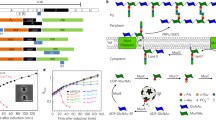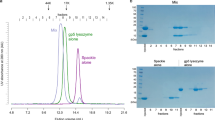Abstract
Comparative kinetic analysis of inactivation of bacteriophage MS2 infectivity and aminoalkylation of a model protein (trypsin inhibitor) with oligoaziridines was performed in order to evaluate the selectivity of viral RNA modification with oligocationic reagents. The transition from ethyleneimine monomer to di-, tri-, and tetramer leads to a sharp increase in the rate constant of infectivity inactivation, whereas the rate constant of protein modification changes insignificantly. The selectivity coefficient of the phage RNA aminoalkylation relative to trypsin inhibitor modification increases in this series by more than an order of magnitude. This effect is probably associated with the strengthening of the reagent binding to the nucleic acid, which implies a reaction mechanism that involves the formation of a reactive intermediate. The latter might be an electrostatic complex of the oligocationic reagent and RNA, the only polyanion in the virion. A pronounced decrease in the rate constant of infectivity inactivation in the presence of multiply charged anions (in phosphate buffer) and a biogenic polyamine (spermine) favors this hypothesis. Increasing the reaction temperature increases the rate constant of infectivity inactivation and decreases selectivity of the viral RNA modification.
Similar content being viewed by others
REFERENCES
Budowsky, E. I. (1991) Adv. Virus Res., 39, 255-290.
Christianson, G. G., Pemberton, J. R., and Koski, T. A. (1980) J. Clin. Microbiol., 11, 377-379.
Warrington, R. E., Cunliff, H. R., and Bachrach, H. L. (1973) Am. J. Vet. Res., 34, 1087-1091.
Bahnemann, H. G. (1990) Vaccine, 8, 299-303.
York, S. M., and York, C. J. (1991) JAVMA, 199, 1419-1422.
Barteling, S. J., and Vreeswijk, J. (1991) Vaccine, 9, 75-88.
Hassanain, M. M. (1992) Res. Elev. Med. Vet. Pays Trop., 45, 231-234.
Hulskotte, E. G., Dings, M. E., Norley, S. G., and Osterhaus, A. D. (1997) Vaccine, 15, 1839-1845.
Kyvsgaard, N. C., Hoier, R., Bruck, I., and Nansen, P. (1997) Acta Vet. Seanol., 38, 225-233.
Budowsky, E. I., Zalesskaya, M. A., Nepomnyaschaya, N. M., and Kostyanovsky, R. G. (1996) Vaccine Res., 5, 29-39.
Earley, J. E., O.Rourke, C. E., Clapp, L. B., Edwards, J. O., and Lawes, B. C. (1958) J. Am. Chem. Soc., 80, 3458-3462.
Kostyanovsky, R. G., Leshchinskaya, V. P., Alekperov, R. K., Kadorkina, G. K., Shastova, L. L., El′natanov, Yu. I., Gromova, L. L., Aliev, A. E., and Chervin, I. I. (1988) Izv. Akad. Nauk SSSR, 11, 2566-2575.
Epstein, J., Rosental, R. W., and Ess, R. J. (1955) Analyt. Chem., 27, 1435-1439.
Rogerson, D. L., and Rushizky, G. W. (1975) Analyt. Biochem., 67, 675-678.
Yamamoto, K. R., Alberts, B. M., Benzinger, R., Lawhorne, L., and Treiber, G. (1970) Virology, 40, 734-744.
Righetti, P. G. (1983) Isoelectric Focusing: Theory, Methodology and Applications, Elsevier Biomedical Press, Amsterdam-New York-Oxford.
O.Connor, T. R., Boiteux, S., and Laval, J. (1988) Nucleic Acids Res., 16, 5879-5893.
Hemmiki, K., and Ludlum, D. B. (1981) J. Natl. Cancer Inst., 73, 1021-1027.
Hemminki, K. (1984) Chem.-Biol. Interact., 48, 249-260.
Voloshchuk, T. P., Patskovskii, Yu. V., and Potopal′skii, A. I. (1993) Bioorg. Khim., 19, 484-493.
Hemminki, K., Peltonen, K., and Vodicka, P. (1989) Chem.-Biol. Interact., 70, 289-303.
Shooter, K. V., Howse, R., Shah, S. A., and Lawley, P. D. (1974) Biochem. J., 137, 303-312.
Voloshchuk, T. P., Patskovskii, Yu. V., and Potopal′skii, A. I. (1993) Bioorg. Khim., 19, 562-569.
Shooter, K. V., Howse, R., and Merrifield, R. K. (1974) Biochem. J., 137, 313-317.
Rattery, M. A., and Cole, R. D. (1963) Biochem. Biophys. Res. Commun., 10, 467-472.
Steiner, R. F. (1965) Biochim. Biophys. Acta, 100, 14.
Author information
Authors and Affiliations
Rights and permissions
About this article
Cite this article
Tsvetkova, E.A., Nepomnyaschaya, N.M. Principles of Selective Inactivation of a Viral Genome. Comparative Kinetic Study of Modification of the Viral RNA and Model Protein with Oligoaziridines. Biochemistry (Moscow) 66, 875–884 (2001). https://doi.org/10.1023/A:1011952702725
Issue Date:
DOI: https://doi.org/10.1023/A:1011952702725




